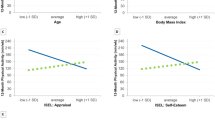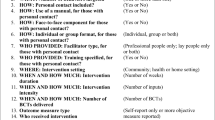Abstract
Background: Little evidence exists about the effectiveness of “interactive” computer-tailored interventions and about the combined effectiveness of tailored interventions on physical activity and diet. Furthermore, it is unknown whether they should be executed sequentially or simultaneously.Purpose: The purpose of this study was to examine (a) the effectiveness of interactive computer-tailored interventions for increasing physical activity and decreasing fat intake and (b) which intervening mode, sequential or simultaneous, is most effective in behavior change.Methods: Participants (N = 771) were randomly assigned to receive (a) the physical activity and fat intake interventions simultaneously at baseline, (b) the physical activity intervention at baseline and the fat intake intervention 3 months later, (c) the fat intake intervention at baseline and the physical activity intervention 3 months later, or (d) a place in the control group.Results: Six months postbaseline, the results showed that the tailored interventions produced significantly higher physical activity scores, F(2, 573) = 11.4, p < .001, and lower fat intake scores, F(2, 565) = 31.4, p < .001, in the experimental groups when compared to the control group.Conclusions: For both behaviors, the sequential and simultaneous intervening modes showed to be effective; however, for the fat intake intervention and for the participants who did not meet the recommendation in the physical activity intervention, the simultaneous mode appeared to work better than the sequential mode.
Similar content being viewed by others
References
Zyriax BC, Windler E: Dietary fat in the prevention of cardiovascular disease — A review.European Journal of Lipid and Science Technology. 2000,102:1–5.
Kuller LH: Dietary fat and chronic diseases: Epidemiologic overview.Journal of the American Dietetic Association. 1997,97:s9-s15.
U.S. Department of Health and Human Services:Physical Activity and Health: A Report of the Surgeon General. Atlanta, GA: Centers for Disease Control and Prevention, National Center for Chronic Disease Prevention and Health Promotion, 1996.
Paffenbarger Jr. RS, Hyde RT, Wing AL, Hsieh CC: Physical activity, all-cause mortality, and longevity of college alumni.New England Journal of Medicine. 1986,314:605–613.
Chanmugam P, Guthrie JF, Cecilio S, et al.: Did fat intake in the United States really decline between 1989–1991 and 1994–1996?Journal of the American Dietetic Association. 2003,103:867–872.
De Henauw S, De Backer G: Nutrient and food intakes in selected subgroups of Belgian adults.British Journal Nutrition. 1999,81:s37-s42.
Steptoe A,Wardle J, Fuller R, et al.: Leisure-Time physical exercise: Prevalence, attitudinal correlates, and behavioral correlates among young Europeans from 21 countries.Preventive Medicine. 1997,26:845–854.
Pate RR, Pratt M, Blair SN, et al.: Physical activity and public health.Journal of the American Medical Association. 1995,273:402–407.
NIH Consensus Statement.Physical Activity and Cardiovascular Health. Bethesda, MD: National Institutes of Health, 1995.
Commission of the European Communities.Nutrient and Energy Intakes for the European Community. Brussels, Belgium: Reports of the Scientific Committee for Food, 2003.
Krauss RM, Deckelbaum RJ, Ernst N, et al.: Dietary guidelines for healthy American adults. A statement for health professionals from the Nutrition Committee and American Heart Association.Circulation. 1996,94:1795–1800.
Ryan P, Lauver DR: The efficacy of tailored interventions.Journal of Nursing Scholarship. 2002,34:331–337.
Kreuter M, Farrell D, Olevitch L, Brennam L:Tailoring Health Messages: Customizing Communication With Computer Technology. Mahwah,NJ: Lawrence Erlbaum Associates, Inc., 2000.
De Vries H, Brug J: Computer-tailored interventions motivating people to adopt health promoting behaviors: Introduction to a new approach.Patient Education and Counseling. 1999,36:99–105.
Skinner CS, Campbell MK, Rimer BK, et al.: How effective is tailored print communication?Annals of Behavioral Medicine. 1999,21:290–298.
Brug J, Steenhuis I, van Assema P, De Vries H: The impact of a computer-tailored nutrition intervention.Preventive Medicine. 1996,25:236–242.
Segar M., Jayaratne T, Hanlon J, Richardson CR: Fitting fitness into women’s lives: Effects of a gender-tailored physical activity intervention.Women’s Health Issues. 2002,12:338–347.
Bock BC, Marcus BH, Pinto BM, Forsyth LH: Maintenance of physical activity following an individualized motivationally tailored intervention.Annals of Behavioral Medicine. 2001,23:79–87.
Bull FC, Kreuter MW, Scharff DP: Effects of tailored, personalized and general health messages on physical activity.Patient Education and Counseling. 1999,36:181–192.
Marcus BH, Bock BC, Pinto BM, et al.: Efficacy of an individualized, motivationally-tailored physical activity intervention.Annals of Behavioral Medicine. 1998,20:174–180.
Marcus BH, Emmons KM, Simkin-Silverman LR, et al.: Evaluation of motivationally tailored vs. standard self-help physical activity interventions at the workplace.American Journal of Health Promotion. 1998,12:246–253.
Stevens VJ, Glasgow RE, Toobert DJ, et al.: One-year results from a brief, computer-assisted intervention to decrease consumption of fat and increase consumption of fruits and vegetables.Preventive Medicine. 2003,36:594–600.
Oenema A, Brug J: Feedback strategies to raise awareness of personal dietary intake: Results of a randomized controlled trial.Preventive Medicine. 2003,36:429–439.
Armitage CJ, Conner M: Efficacy of a minimal intervention to reduce fat intake.Social Science and Medicine. 2001,52:1517–1524.
Brug J, van Assema P: Differences in use and impact of computer-tailored dietary fat-feedback according to stage of change and education.Appetite. 2000,34:285–293.
De Bourdeaudhuij I, Brug J: Tailoring dietary feedback to reduce fat intake: An intervention at the family level.Health Education Research. 2000,15:449–462.
Brug J: Dutch research into the development and impact of computer-tailored nutrition education.European Journal of Clinical Nutrition. 1999,53:s78-s82.
Brug J, Campbell M, van Assema P: The application and impact of computer-generated personalized nutrition education: A review of the literature.Patient Education and Counseling. 1999,36:145–156.
Strecher V, Wang C, Derry H, et al.: Tailored interventions for multiple risk behaviors.Health Education Research. 2002,17:619–626.
Jakicic JM,Wing RR, Winters-Hart C: Relationship of physical activity to eating behaviors and weight loss in women.Medicine and Science in Sports and Exercise. 2002,34:1653–1659.
Gillman MW, Pinto BM, Tennstedt S, et al.: Relationships of physical activity with dietary behaviors among adults.Preventive Medicine. 2001,32:295–301.
Emmons KM, Marcus BH., Linnan L, et al.: Mechanisms in multiple risk factor interventions—Smoking, physical-activity and dietary-fat intake among manufacturing workers.Preventive Medicine. 1994,23:481–489.
Wilcox S, Parra-Medina D, Thompson-Robinson M, Will J: Nutrition and physical activity interventions to reduce cardiovascular disease risk in health care settings: A quantitative review with a focus on women.Nutrition Reviews. 2001,59:197–214.
Writing group of the PREMIER clinical trial: Effects of comprehensive lifestyle modification on blood pressure control: Main results of the PREMIER clinical trial.Journal of the American Medical Association. 2003,289:2083–2093.
Boudreaux ED, Wood KB, Mehan D, et al.: Congruence of readiness to change, self-efficacy, and decisional balance for physical activity and dietary fat reduction.American Journal of Health Promotion. 2003,17:329–336.
Campbell MK, Tessaro I., De Vellis B, et al.: Effects of a tailored health promotion, program for female blue-collar workers: Health works for women.Preventive Medicine. 2002,34:313–323.
Calfas KJ, Sallis JF, Zabinski MF, et al. Preliminary evaluation of a multicomponent program for nutrition and physical activity change in primary care: PACE+ for adults.Preventive Medicine. 2002,34:153–161.
Vandelanotte C, De Bourdeaudhuij I: Acceptability and feasibility of a computer-tailored physical activity intervention using stages of change: Project FAITH.Health Education Research. 2003,18:304–317.
Vandelanotte C, De Bourdeaudhij I, Brug J: Acceptability and feasibility of an interactive computer-tailored fat intake intervention in Belgium.Health Promotion International (in press).
Ajzen I: From intentions to actions: A theory of planned behavior. In Kuhl J, Beckman J (eds),Action-Control: From Cognition to Behaviour. Heidelberg, Germany: Springer, 1985, 11–39.
Prochaska JO, DiClemente CC, Norcross JC: In search of how people change. Applications to addictive behaviors.American Psychologist. 1992,47:1102–1114.
Brug J, Steenhuis I, van Assema P, et al.: Computer-tailored nutrition education: Differences between two interventions.Health Education Research. 1999,14:249–256.
Brug J, Steenhuis I, van Assema P, De Vries H: The impact of a computer-tailored nutrition intervention.Preventive Medicine. 1996,25:236–242.
Craig CL, Marshall AL, Sjostrom M, et al.: International Physical Activity Questionnaire: 12-country reliability and validity.Medicine and Science in Sports and Exercise. 2003,35:1381–1395.
Rzewnicki R, Auweele YV, De Bourdeaudhij I: Addressing overreporting on the International Physical Activity Questionnaire (IPAQ) telephone survey with a population sample.Public Health Nutrition. 2003,6:299–305.
Vandelanotte C, Matthys C, De Bourdeaudhij I: Reliability and validity of a computerised questionnaire to measure fat intake in Belgium.Nutrition Research (in press).
Ainsworth BE, Haskell WL, Leon SL, et al.: Compendium of physical activities: Classification of energy costs of human physical activities.Medicine and Science in Sport and Exercise. 1993,25:71–80.
Ainsworth BE, Haskell WL, Whitt MC, et al.: Compendium of physical activities: An update of activity codes and MET intensities.Medicine and Science in Sports and Exercise. 2000,32:498–504.
National Council on Nutrition (Nationale raad voor de voeding):Dietary Recommendations for Belgium (Voedingsaanbevelingen voor België). Brussels, Belgium: Ministry of Social Affairs, Public Health and Environment, 1997.
Lee IM, Rexrode KM, Cook NR, et al.: Physical activity and coronary heart disease in women—Is “no pain, no gain” passe?Journal of the American Medical Association. 2001,285:1447–1454.
Iwane M, Arita M, Tomimoto S, et al.: Walking 10,000 steps/day or more reduces blood pressure and sympathetic nerve activity in mild essential hypertension.Hypertension Research. 2000,23:573–580.
Pescatello LS, Murphy D, Costanzo D: Low-intensity physical activity benefits blood lipids and lipoproteins in older adults living at home.Age and Ageing. 2000,29:433–439.
Ryan P, Lauver DR: The efficacy of tailored interventions.Journal of Nursing Scholarship. 2002,34:331–337.
Brug J, Vanassema P, Kok G, et al.: Self-rated dietary-fat—Association with objective assessment of fat, psychosocial factors, and intention to change.Journal of Nutrition Education. 1994,26:218–223.
Macdiarmid J, Blundell J: Assessing dietary intake: Who, what and why of under-reporting.Nutrition Research Reviews. 1998,11:231–253.
Mennell S, Murcott A, van Otterloo A:The Sociology of Food: Eating, Diet and Culture. London: Sage, 1992.
Zunft HJ, Friebe D, Seppelt B, et al.: Perceived benefits of healthy eating among a nationally-representative sample of adults in the European Union.European Journal of Clinical Nutrition. 1997,51:s41-s46.
Buziarsist J, Demarest S, Gisle L, Taffoteau J, et al.:Belgian Health Enquiry 2001, Part 3 lifestyle: Physical activity (IPH/ EPI Reports No. 2002-22, D/2002/2505/40). Brussels, Belgium: Scientific Institute for Public Health, 2001.
Author information
Authors and Affiliations
Corresponding author
Additional information
This study was financially supported by the Ghent University and the Flemish Fund for Scientific Research.We thank Katrien Bogaert, Griet Bonamie, Nele Callewaert, Hilde Decrop, Evelyn Vanbesien, and Els Van Cleemput for their cooperation in data gathering.
About this article
Cite this article
Vandelanotte, C., De Bourdeaudhuij, I., Sallis, J.F. et al. Efficacy of sequential or simultaneous interactive computer-tailored interventions for increasing physical activity and decreasing fat intake. ann. behav. med. 29, 138–146 (2005). https://doi.org/10.1207/s15324796abm2902_8
Issue Date:
DOI: https://doi.org/10.1207/s15324796abm2902_8




